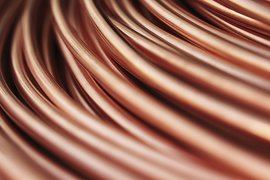 Modern copper ores contain less than 0.6% copper, and less than 2% total volume of economic ore minerals (including copper). A majority of the ore is comprised of unwanted rock and gangue minerals (typically silicate minerals or oxide minerals). Separation of ore minerals from gangue minerals entails complicated and labor intensive processes.
Modern copper ores contain less than 0.6% copper, and less than 2% total volume of economic ore minerals (including copper). A majority of the ore is comprised of unwanted rock and gangue minerals (typically silicate minerals or oxide minerals). Separation of ore minerals from gangue minerals entails complicated and labor intensive processes.
To obtain high-purity copper, the ore is concentrated for processing by crushing and grinding it into a powder containing 20-30% copper. The concentrates are smelted and the sulfide minerals are partially oxidized to yield a layer of “matte”, a mix of copper-iron sulfide and slag, and an upper layer of waste. The slag is tapped from the furnace and the copper matte sent onward to a convertor where lime and silica are added. The additions react with the iron oxide, causing it to form into a slag for removal. Once the iron is removed, the remaining Sulfur is oxidized and removed from the copper sulfide, yielding what is known as blister copper, due to its bumpy surface. Blister copper has a minimum copper content of 98.5%.
Blister copper is refined to high-purity copper in a cylindrical furnace where the last of the sulfur and any residual oxygen is removed. The molten copper is then poured into a casting wheel to form anodes that will allow the copper to be further refined through electrorefining, transferring the highest purity copper to cathode sheets. The cathodes contain 99.99+% copper. Copper of this purity is the main product of copper manufacturing who sells the copper in differing forms (cathode, rod or bar).
The composition of the final high-purity copper requires quantification of trace elements to ensure its composition, but the analysis of trace elements in high-purity copper is challenging, using techniques that require sample digestion prior to analysis. Digestion procedures are often complex, time-consuming and increase the risk of sample contamination during preparation. More importantly, these procedures often dilute the sample to such an extent that the analytes of interest are present in solution at levels below the detection limit of the technique being used to measure them.
The Teledyne Leeman Lab’s Prodigy DC Arc Spectrometer allows copper samples to be analyzed in their solid metallic form and continues to be the primary technique used by manufacturers of Grade 1 cathode copper as it provides the sensitivity required for the application. DC Arc also eliminates the need for sample dissolution and greatly increases the speed with which samples are prepared and analyzed.
Our newly released Application Note: AN1401 - Analysis of Trace Elements, Including Sulfur, in Copper demonstrates the ability of the Prodigy DC Arc to determine trace elements, including sulfur, in high-purity copper. Nitrogen was used to purge the optical path between the DC Arc and the spectrometer’s optical entrance window to allow for the determination of sulfur. The instrument was calibrated with two sets of high-purity copper standards that contained the analytes of interest at concentrations which ranged from 0.01 to 320.0 ppm. Results demonstrated reproducible detection limits for the determination of trace elements in high-purity copper.
Blog Sources
Information in this blog was derived from the following sources. Information maybe be edited in content and length. For further information, please refer to the source document and/or website.
- http://www.ilo.org/safework_bookshelf/english?content&nd=857170994
- http://en.wikipedia.org/wiki/Copper_extraction_techniques
- http://en.wikipedia.org/wiki/Gangue
- 4) http://en.wikipedia.org/wiki/Ore

